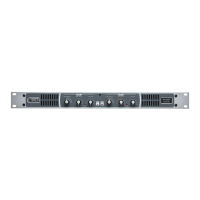
Do you have a question about the Cloud 24 Series and is the answer not in the manual?
| Type | Power Amplifier |
|---|---|
| Channels | 2 |
| Signal-to-Noise Ratio | >100dB |
| Damping Factor | >200 |
| Frequency Response | 20Hz - 20kHz |
| Input Impedance | 20k ohms |
| Cooling | Convection |
Guidance on safe installation practices, including avoiding moisture, heat, and ensuring proper ventilation.
Details compliance with European EMC and electrical safety standards for the product.
Information on compliance with regulations regarding hazardous substances and electronic waste.
General safety advice, including earthing requirements and handling of high voltage.
Warning about touching terminals with hazardous live symbols when power is supplied.
Instructions for replacing the IEC receptacle fuse and advice on potential faults.
Emphasizes that the unit has no user-serviceable parts and requires qualified personnel for repairs.
Brief introduction to the 24 Series mixer-amplifiers and their applications.
Lists the specific models covered by this installation and user guide.
Highlights the key features and capabilities of the 24 Series mixer-amplifiers.
Lists optional accessories and modules compatible with the 24 Series.
Details the items included in the product packaging.
Visual representation of the unit's internal signal flow and connections.
Explanation of the controls and indicators located on the front of the unit.
Description of the connectors, switches, and indicators on the rear of the unit.
Guidance on rack mounting, depth requirements, and placement for optimal access and performance.
Information on cooling systems, ambient temperature limits, and ensuring adequate airflow.
Details on the universal power supply, voltage and frequency compatibility, and energy efficiency.
Information on the accessible mains fuse and internal fuses for power supply protection.
Describes the four stereo line inputs and their characteristics.
Explains rear panel gain controls for line input sensitivity and signal level indication.
Details front panel and remote control options for selecting music sources.
Describes front panel controls for adjusting music volume in each zone.
Explains compatibility with remote control plates for source and level adjustments.
Describes rear panel controls for adjusting bass and treble for music signals.
Explains how Line Input 4 can be set to automatically mute other sources.
Details the microphone input, its impedance, and phantom power capability.
Describes front panel controls for adjusting microphone volume per zone.
Describes rear panel EQ controls for adjusting microphone signal frequency response.
Explains DIP switch settings for paging mode and mic-over-music priority.
Describes the PAGING ACCESS connector for contact-closure paging microphones.
Details the low-impedance and high-voltage speaker outputs and protection features.
Instructions for connecting 4 or 8 ohm loudspeakers, including load impedance warnings.
Instructions for connecting 70/100 V-line systems, including high-pass filter usage.
Explains how the 24-120 model can share its total power between zones in Hi-Z mode.
Describes auxiliary outputs for driving additional amplifiers or for recording.
Details the utility output for loop amplifiers or secondary area speakers.
Guidance on connecting remote active modules like LM-2, BT-1, L-1, and M-1.
Advice on using multiple 24 Series units for multi-zone sound systems.
Explains the Music Mute input for integration with fire alarm systems.
Details the energy-saving Auto Power Down feature and its activation.
Explains how to control music source and level using external DC voltages.
Describes using the Facility Port as a general-purpose auxiliary balanced line input.
Provides a list of common RS-232 commands for controlling the mixer-amplifier.
Diagrams showing the locations of internal PCB jumpers for configuration.
Lists internal jumpers, their purposes, locations, and factory default settings.
Explanation of reduced output power indicated by a flashing green STATUS LED.
Explanation of amplifier shutdown due to over-temperature indicated by flashing red LED.
Details protection schemes like short circuit, over-current, and DC protection.
Advice on minimizing electromagnetic interference when installing the unit.
Guidelines for proper earthing to prevent ground loops and hum.
Specifications for frequency response, sensitivity, impedance, and headroom of line inputs.
Specifications for microphone input frequency response, sensitivity, impedance, and phantom power.
Specifications for frequency response, sensitivity, impedance, and noise gate of the facility input.
Specifications for output power, minimum load, frequency response, and protection for main outputs.
Details power consumption figures for standby, idle, and various output levels.
Provides heat loss figures in kJ/hr and BTU/hr for different operating states.
Lists the net and shipping dimensions of the mixer-amplifier units.
Specifies the net and shipping weights of the mixer-amplifier units.